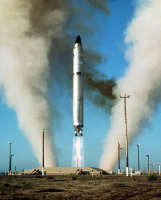








An intercontinental ballistic missile (ICBM) is a guided ballistic missile with a minimum range of more than 5,500 kilometres (3,400 mi) primarily designed for nuclear weapons delivery (delivering one or more thermonuclear warheads). Similarly conventional, chemical and biological weapons can also be delivered with varying effectiveness, but have never been deployed on ICBMs. Most modern designs support multiple independently targetable reentry vehicles (MIRVs), allowing a single missile to carry several warheads, each of which can strike a different target.
Development of ICBM
Sergei Pavlovich Korolev (1907-1966) is widely regarded as the founder of the Soviet space program,On July 27, 1944, the authorities "paroled" Korolev and on Sept. 8, 1945, Korolev traveled to Germany for evaluation and restoration of A-4 ballistic missiles.
The Soviet Union announces that it has successfully tested an intercontinental ballistic missile (ICBM) capable of being fired “into any part of the world.” The announcement caused great concern in the United States, and started a national debate over the “missile gap” between America and Russia.
For years after World War II, both the United States and the Soviet Union had been trying to perfect a long-range missile capable of carrying nuclear warheads. Building on the successes of Nazi Germany in developing the V-1 and V-2 rockets that pummeled Great Britain during the last months of World War II, both American and Russian scientists raced to improve the range and accuracy of such missiles. (Both nations relied heavily on captured German scientists in their efforts.) In July 1957, the United States seemed to win the race when the Atlas, an ICBM with a speed of up to 20,000 miles an hour and an effective range of 5,000 miles, was ready for testing. The test, however, was a disaster. The missile rose only about 5,000 feet into the air, tumbled, and plunged to earth. Just a month later, the Soviets claimed success by announcing that their own ICBM had been tested, had “covered a huge distance in a brief time,” and “landed in the target area.” No details were given in the Russian announcement and some commentators in the United States doubted that the ICBM test had been as successful as claimed. Nevertheless, the Soviet possession of this “ultimate weapon,” coupled with recent successful test by the Russians of atomic and hydrogen bombs, raised concerns in America. If the Soviets did indeed perfect their ICBM, no part of the United States would be completely safe from possible atomic attack.
Less than two months later, the Soviets sent the satellite Sputnik into space. Concern quickly turned to fear in the United States, as it appeared that the Russians were gaining the upper hand in the arms and space races. The American government accelerated its own missile and space programs. The Soviet successes–and American failures–became an issue in the 1960 presidential campaign. Democratic challenger John F. Kennedy charged that the outgoing Eisenhower administration had allowed a dangerous “missile gap” to develop between the United States and the Soviet Union. Following his victory in 1960, Kennedy made missile development and the space program priorities for his presidency.